The Alaska League is a term often referred to as a means of encompassing baseball as it is known today in the 49th state. However, the words “Alaska League” are a bit of a misnomer.
Not Lost From History
BY DONALD A. DENNIS
The Alaska League is a term often referred to as a means of encompassing baseball as it is known today in the 49th state.
However, the words “Alaska League” are a bit of a misnomer. The best it has ever been — and that happens to be the era from 1998 to the present — is a strong association of teams joining together to give the appearance of a traditional league.
Plenty of baseball at the amateur level was played in Fairbanks, and other parts of the state, prior to the arrival of the Goldpanners in 1960. No doubt, though, that the Goldpanners of sponsor and manager Red Boucher – formed at the urging of the University of Alaska basketball coach Ray Wheeler – ushered in a new era. And, the new era was not just Alaska but reached to the national non-pro stage as semi-pro ball became transformed from a field of play for former professionals to domination by college undergraduates.
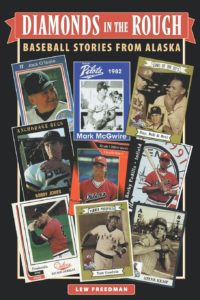 Returning to the idea of the Alaska League, however, is important as the “league” will be featured in a documentary this summer and its history is to be one of the focal points.
Returning to the idea of the Alaska League, however, is important as the “league” will be featured in a documentary this summer and its history is to be one of the focal points.
The best work to date is Lew Freedman’s book “Diamonds in the Rough” published in 2002. Lew, now at the Chicago Tribune, is a former Anchorage Daily News sports writer (and one of the better ones to grace Alaskan sports pages).
The first baby steps toward an “Alaska League” were made in the spring of 1968 by a fellow from Anchorage named Joe Keenan. His son, Frank, had pitched summer ball and spent some time with the Goldpanners in the early 60s.
The move went from Joe Keenan to a dozen or so Anchorage businessmen — headed by John Stepp — to the hiring of Paul W. Deese as field manager. Keenan, Stepp, et. al, had a dream to compete with the Goldpanners and the masterful Deese accomplished that for them and also had an eye to bigger and better things.
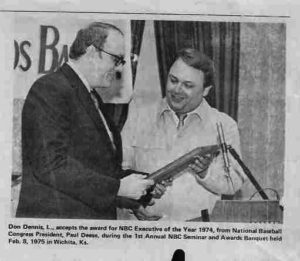 It was Deese that joined with myself and Fairbanks lawyer Ed Merdes to make the initial trips to the Kenai Peninsula with the idea of a third team for Alaska. That team, the Peninsula Oilers, was born in 1974 and so was the first “league” arrangement.
It was Deese that joined with myself and Fairbanks lawyer Ed Merdes to make the initial trips to the Kenai Peninsula with the idea of a third team for Alaska. That team, the Peninsula Oilers, was born in 1974 and so was the first “league” arrangement.
It was a dandy as the three Alaska teams played each other 12 times and each club played a total of eight other teams four games each that would count in the standings — a neat 44-game “league” schedule.
What resulted was one of the great stories of Alaska baseball. The three Alaska teams got into a heated race and all finished within 1 1/2 games of each other with Fairbanks finishing one-half game out after having a game against one of the ‘outside’ teams rained out. In fact, in the month of July — with all three Alaska teams needing every win — the visiting teams, which were some of the best amateur teams in the west, had an Alaska record of 0-31 and a rainout. The rainout cost Fairbanks. Kenai also got a forfeit win when the Pueblo, CO, Brewers went on a float trip and failed to get to the stadium in time for the game.
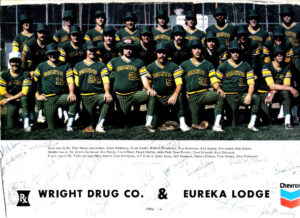 The mission to even things out was done entirely by Fairbanks. Goldpanners directors — with a single investor from Palmer — formed the Valley Green Giants for the 1976 season. With four teams a really good 48-game schedule was arranged. This lasted for four years until the Giants fell apart after the 1979 season when local operators failed to turn over concession receipts in order to pay bills.
The mission to even things out was done entirely by Fairbanks. Goldpanners directors — with a single investor from Palmer — formed the Valley Green Giants for the 1976 season. With four teams a really good 48-game schedule was arranged. This lasted for four years until the Giants fell apart after the 1979 season when local operators failed to turn over concession receipts in order to pay bills.
The stalemate led to the disbanding of the Giants, and the Oilers and Anchorage Pilots decided to abandon the league. At the same time the North Pole Nicks and Anchorage Bucs took the field, joined the Alaska League, and it was back to three teams but only the original Goldpanners remained.
The other teams formed something called the Alaska Central Baseball League and operated that way for several years before returning to the fold.
In 1986, the Hawaii Island Movers joined the Alaska League. They were quickly followed by the San Francisco Senators and the Pullman, WA, Palouse Empire Cougars. It turned out to be a good thing as the Bucs announced in the fall of 1987 they would take ’88 off to reorganize. The real bomb came on May 17, 1988, when the Mat-Su Miners — a team organized to replace the Giants — announced they were folding. Three days later the Anchorage Pilots folded and a day after that the North Pole Nicks went down.
Left as the Alaska League were the Goldpanners, Oilers, and three teams from outside Alaska — Pullman, San Francisco and the Hawaii Island Movers.
Mat-Su, the Bucs and the Pilots all returned in 1989 but the state was again divided into two leagues with the Goldpanners, Hawaii and Bucs in the Alaska League. North Pole had an associate membership as did a team in Anchorage operated by Emmitt Wilson, labeled the Alaska 49ers. When the teams which sat out the 1988 season returned in ’89, there was an attempt to have an Alaska League but the Anchorage Pilots team immediately violated league rules and was expelled. The Miners and Oilers chose to go with them and put the Central League back in business.
Such was the state of affairs until late into the 1990s. There was a huge amount of activity involved in all of the above shuffling but finally in November 1997 a meeting was held at a Seattle airport hotel which brought the present arrangement. In attendance were myself, Dennis Mattingly of the Bucs and Jack Slama, who had served as commissioner of the Central League.
The Seattle meeting set the stage for six teams to take the field in the Alaska League for the 1998 season…. the Goldpanners, four other Alaskan teams and the Hawaii Island Movers.
Hawaii remained with the group through the 2000 season but in 2001 dropped out and was immediately replaced by Athletes in Action setting up the alignment to this day.
The current lineup is the best ‘league’ setup the state has seen but really it is just an association of six teams, not a league in the popularly accepted sense of a central authority.
ALPHABETICAL LIST
Following is an alphabetical list of persons who played important, if sometimes short, roles in the development of Alaska amateur baseball as we know it today:
JIM ARNESS — Community leader in Kenai who answered the call to gather persons interested in the formation of a third Alaska team, one to be headquartered in Kenai. Arness set up meetings for myself, Ed Merdes and Paul Deese and the Peninsula Oilers were born due to the follow-up work of a number of Kenai/Soldotna area people.
JOE ARMSTRONG — Joe, now deceased, was the first Booster Club president for the Glacier Pilots and in the late 70s got involved in the management end. He served as board president for many years and although he was never officially the general manager, he served as the Pilots’ representative to “league” meetings.
EMMETT ASHFORD — Emmett, the first black major league umpire, took a leave from his job in the Office of the Commissioner in 1972 and for two years served as the chief umpire and, in effect, commissioner over Alaska’s two teams.
MIKE BAXTER — Mike came along as one of a string of qualified general managers of the Kenai Peninsula Oilers in the 1990s. In addition to running his team, Mike was interested in busing, and had a small side venture which transported Alaska League teams all over the state for a number of years with either himself or ‘Vern’ at the helm. Mike had his own highway coach and later purchased the Goldpanners/Anchorage Bucs highway coach when Dennis Mattingly of the Bucs fell ill. Baxter heavily contributed to all manner of Alaska League affairs. Baxter’s wife, Peggy, operated a Bingo permit sponsored by the team and was responsible for keeping the Oilers on strong footing for a number of years.
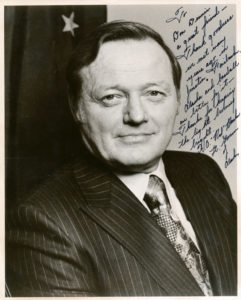 H.A. “RED” BOUCHER — Nothing can be written or said about baseball in Alaska generally, including the Alaska League, without paying honor to Red Boucher. Boucher, who along with Ray Wheeler got the Pan Alaska team on the field in the North of the Range League in 1960, did all of the ground work and leg work that resulted in the Alaska League, which for at least 25 years ruled the nation as the top amateur baseball association. The Goldpanners (1972-73-74-76-80-02) , the Glacier Pilots (1969, 1971, 1975, 1982), the Kenai Peninsula Oilers (1977), and the Mat-Su Miners (1987) all took national titles home to Alaska in that era. Boucher, a promoter first class, was a Chief Petty Officer who retired to Fairbanks and set sail in leading a strong political life as well as developing the baseball to a national level.
H.A. “RED” BOUCHER — Nothing can be written or said about baseball in Alaska generally, including the Alaska League, without paying honor to Red Boucher. Boucher, who along with Ray Wheeler got the Pan Alaska team on the field in the North of the Range League in 1960, did all of the ground work and leg work that resulted in the Alaska League, which for at least 25 years ruled the nation as the top amateur baseball association. The Goldpanners (1972-73-74-76-80-02) , the Glacier Pilots (1969, 1971, 1975, 1982), the Kenai Peninsula Oilers (1977), and the Mat-Su Miners (1987) all took national titles home to Alaska in that era. Boucher, a promoter first class, was a Chief Petty Officer who retired to Fairbanks and set sail in leading a strong political life as well as developing the baseball to a national level.
JACK BRUSHERT — Jack played for the Glacier Pilots in their first season, 1969, and then in the mid-70s became the general manager. Jack guided the Pilots through some of their roughest time into the early 80s.
WAYNE DUNWORTH — Like Swearingen, a newspaperman and baseball guy who migrated to Kenai from Liberal. Dunworth was a league rep from the Oilers and was a key vote when the decision was made to include Hawaii in the league in 1986. His successor, Coral Seymour, had the opposite view and joined in yet another league split. Both men are now deceased.
JOHN HALE — The Commander, as he was known, was the general manager of the Alaska State Fair in 1975 when he openly accepted the proposal from Ed Merdes and myself that a fourth Alaska team be formed and located in Palmer. In an early December 1975 meeting in Fairbanks John unfurled a map of the fairgrounds and a location for the diamond was designated on the spot. He then helped immensely in the construction in the spring of ’76 and the Valley Green Giants played their first game on June 11 in one of the most remarkable construction projects ever. The few following are some of the major contributors to that amazing project and their contributions: Vern France and Len Melton—heavy equipment operators who arrived after their day jobs to work long into the night getting the forest where the field was to be located knocked down, cleared, and leveled; Vic Lawyer — used his equipment to transport pre-built dugouts and drop them in place just before the season opener. The dugouts were built at the Palmer Correctional Facility under the eyes of director Stan Zaborec; Monty Hotchkiss — Monty worked with the Mat-Su School District but his role for the ball club was to till and seed the outfield. He promised grass in 10 days and when the season opened one could see the thin green strands just as he promised.; Palmer American Legion Baseball Team– the ’76 Palmer legion team borrowed farm equipment and hauled all of the sod for the infield and foul areas from the University Farm on Truck Road — a project of several days; Jan Koslosky — State Senator from Palmer and the only person outside Fairbanks to put up seed money for the Green Giants. Koslosky put up $5,000 to join a dozen other backers, all from Fairbanks; Ken Soule — Ken worked in Anchorage but came straight to the fairgrounds every night and worked on the smoothing, root cutting, and other details in getting the field ready for sodding and planting. He once was found asleep in his car in left field the following morning–he had run out of gas using his car to drag the outfield area.
JOE KEENAN — Joe was the Anchorage figure who kept pressing the Goldpanners to assist with the formation of a competitive team in Anchorage. His son, Frank, had pitched for the Panners in the early 60’s. Joe was a state official, director of the Division of Lands, and as such was frequently in Fairbanks and each time would press for a meeting to discuss the formation of an Anchorage team. He finally succeeded in getting me to agree to a July 4, 1968 doubleheader in Anchorage as a means of raising awareness, and of raising funds. It was billed as a best two-of-three for the Alaska NBC Championship, but only two games were scheduled. The Panners boarded their charter to Fairbanks at 9 p.m. with two lop-sided wins, the state title, and the birth of the Pilots assured. A side note, one of the players on the Anchorage team put together for that historical day was none other than Dennis Mattingly, founder and general manager of the Anchorage Bucs, who debuted in 1980.
WALT KOZIE — Co-owner of Plywood Supply lumber company in Fairbanks. Walt specked out the new stadium for Palmer–outfield fence, box seats, dugouts, etc. — anything to do with lumber or hardware–and had it shipped in on a railroad car. The railroad spur runs right behind the right field fence at Hermon Brothers Park–as it was aptly named–and when the initial construction was done there was not enough scrap left over for a good bonfire.
DENNY KRON — Denny became the first official general manager of the Glacier Pilots. Denny worked for John Stepp, an Anchorage auto dealer who became the Pilots’ board president, and doubled as the general manager. Denny stayed with it until Paul Deese decided to make Anchorage his home following the 1971 season.
BOB LOVE — Bob was involved in the American Legion baseball program in Kenai and stepped to the plate to become the first general manager of the Oilers. After Bob the Oilers have enjoyed a string of very good general managers which includes, but is not limited to, Judy Buffington, Max Sweringen, Wayne Dunworth, Coral Seymour, Dwain Gibson, and in recent years Mike Baxter. Some other key names with the Oilers who served as representatives to the Alaska League include Vince O’Reilly, Don Pearson, and Dick Morgan. O’Reilly was also commissioner of the Central League following the break-away in 1980.
RICH MASTRIANO — Mastriano stepped up and took charge of the Palmer baseball situation when the Giants folded. He was the guiding light for the new Miners for most of the early 80s and served as general manager. Among those that worked with Rick were Chuck Griffin, a Green Giants board member who is still with the organization, and the late Stan Zaborac. Stan was an original Giants’ board member and after Mastriano’s tenure became the well-liked general manager. President of the Giants in their final year was former Fairbanks Superintendent of School Elmer Smith and he stayed with the new Miners through their early years.
JERRY McCLAIN — Jerry is important in that he served as field manager for three teams after playing for the Goldpanners in 1968. Jerry returned as manager of the Palo Alto Chris & Bills’ Chevron in 1973 and then took the Green Giants managing job in 1979. He moved from there to North Pole for 1980 and ’81 and on to the Bucs for 1982 and 1983. He also coached Santa Clara University before entering private business in the mid-80s.
BOB MOSS — Bob Moss first came to Alaska in 1973 as an umpire and quickly moved to the head of umpires when the Alaska League was formed in 74 with the addition of the Kenai Oilers. Bob served three years in that capacity. In addition, he brought students from his college classes in San Diego to work youth programs in the Fairbanks area., The jovial ex-football player also lectured at the university and held motivational clinics while in Alaska. Easily the umpire with the most flair ever to grace the Alaska ball parks, which is saying a lot considering Emmitt Ashford, Chuck Clutts, Cece Carlucci, among others..
VINCE O’REILLY — A judge from Kenai who never had anything to do with the Alaska League, per se, but he stepped forward to be the commissioner of the Central League after the 1980 split. Vince was ahead of his time in offering a modified sliding rule for second base, which the Alaska teams adopted ahead of the national swing in that direction. O’Reilly’s sliding rule is in use by the Alaska League presently, being co-opted when the leagues reunited in 1998.
J.J. POWERS — Jack Powers stood side-by-side with Dennis Mattingly when the Bucs were formed for the 1980 season and his promotional genius helped the Bucs gain a solid share of the Anchorage market from the established Glacier Pilots. Jack, now better known as the Bingo King of Anchorage, to this day is a big assist in helping the Bucs in particular and Alaska baseball in general in raising money needed to fund the not-for-profit programs.
RALPH SEEKINS — Successful Fairbanks businessman who joined with myself and Ed Merdes in getting the North Pole Nicks on the field in 1980. Ralph also served as commissioner of the Alaska League from 1991-1998. During his tenure at North Pole, future dealership employee and general manager John Lohrke was brought on board. Other important North Pole figures were Jack Wright and Sharon Mavencamp.
JOHN STEPP — Ford dealer John Stepp was the front person for the Glacier Pilots board of directors when formed in 1969. He worked directly in the operations of the team in the off season and deserves an enormous amount of credit for the eventual success of the young team. So they won’t be completely lost to history some of those other initial board members included, but not limited to, Joe Keenan, Roger Cremo, Ken Wray, and Bob Reeve.
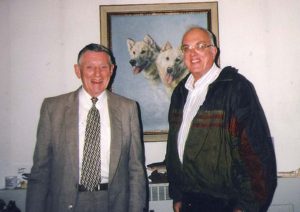 W.G. “BILL” STROECKER — Just as nothing can be written about Alaska baseball without mentioning Red Boucher, it is also true that the highly successful Alaska Goldpanners of Fairbanks can not be written about with acknowledging the direction of Board President W.G.”Bill” Stroecker. A banker, Stroecker was always at the call for the team with his time, and financially “helping out with the rough spots” as he would say. Bill joined the Board of Directors in 1963 and in 1965 he was elected President, holding that position through a succession of 45 one-year terms through his passing in November, 2010. Bill liked everything about baseball, his father played in the 1906 Midnight Sun Game, but the highlights were the High Noon at Midnight Classic and the travels of the Goldpanners, spreading the word of Fairbanks far and wide. Included were international travels and contests with teams from the Dutch Antillies to the Moscow Red Devils with the Ukraine and several Far East National Teams thrown into the mix. Japan, Korea and Taiwan National teams all also visited Fairbanks.
W.G. “BILL” STROECKER — Just as nothing can be written about Alaska baseball without mentioning Red Boucher, it is also true that the highly successful Alaska Goldpanners of Fairbanks can not be written about with acknowledging the direction of Board President W.G.”Bill” Stroecker. A banker, Stroecker was always at the call for the team with his time, and financially “helping out with the rough spots” as he would say. Bill joined the Board of Directors in 1963 and in 1965 he was elected President, holding that position through a succession of 45 one-year terms through his passing in November, 2010. Bill liked everything about baseball, his father played in the 1906 Midnight Sun Game, but the highlights were the High Noon at Midnight Classic and the travels of the Goldpanners, spreading the word of Fairbanks far and wide. Included were international travels and contests with teams from the Dutch Antillies to the Moscow Red Devils with the Ukraine and several Far East National Teams thrown into the mix. Japan, Korea and Taiwan National teams all also visited Fairbanks.
- 2000: Stroecker Name Linked to Fairbanks Baseball History
- 2022: Alumni ’22 Twenty Hall of Fame
- 2022: Stroecker Legacy Alive and Well in Fairbanks
CARL SULLIVAN — Carl worked for an advertising agency in Anchorage and was the first acting general manager of the Glacier Pilots. He served in that capacity for most of the year leading up to the Pilots putting their first team on the field in June, 1969. Carl is now deceased.
MAX SWEARINGEN — Out of Liberal, KS, where one of the nation’s top amateur teams operated, Swearingen was the Kenai Oilers first true general manager. A heart attack took Max shortly after he had worked to try to repair the split leagues in the early 1980s. Max was really never in favor of the famous 1980 split but because of his location south of Anchorage he was trapped by geography and went with the Central League notion.
JOHN M. SWEENEY — John came to Alaska in May, 1976, to be assistant to the general manager of the Valley Green Giants but when Jess Lee departed for the summer, John quickly became the guy on the front line in Palmer. Of course he has since posted a long career in Alaska sports in general, serving as sports editor of the two largest papers in the state, broadcasting, and working with various ball clubs. John was the statistician of the Alaska League during its best four years (1976-1979) and spent many other years working at league affairs in direct and indirect fashion. John has done many good things for sports in Alaska and is particularly well regarded for being co-founder of the Fairbanks APBA League in 1978.
EMMITT WILSON — Saving maybe the best for last. Emmitt has spent 40-plus years involved in Alaska baseball. The former minor league player has been a standout on the field as the Fairbanks shortstop (1962-67), directed American Legion teams in Fairbanks and Anchorage, has done some umpiring and a lot of basketball officiating, started an amateur team (Anchorage 49ers), directed the North Pole Nicks on the field 1989-91 and all the while was a strong commissioner of the Alaska League (1975-1991). Emmitt served as Commissioner of Commerce in the second administration of Alaska’s first governor, William A. Egan (the same years H.A. (Red) Boucher was serving as the state’s first Lieutenant Governor). Emmitt Wilson is the foremost Alaska baseball person in the development of talent and promoting the youth of the state in the sport. To cap things off Emmitt also does some part-time scouting for major league baseball teams.



